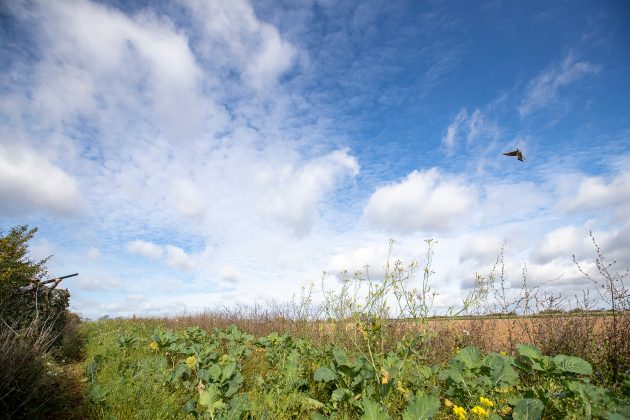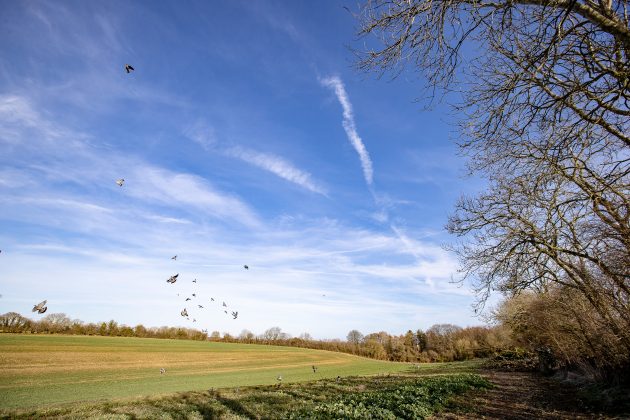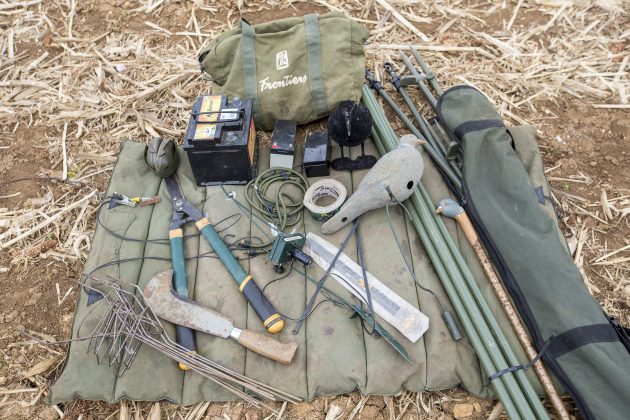Woodpigeon are many a farmer’s nemesis. Managing their numbers is essential, but there is much planning and preparation to be done before any shooting starts. Here is The Field's guide to pigeon shooting
Woodpigeon are many a farmer’s nemesis. Managing their numbers is essential, but there is much planning and preparation to be done before any shooting starts. Here is The Field‘s guide to pigeon shooting. (Read our pigeon shooting calendar here.)
THE FIELD’S GUIDE TO PIGEON SHOOTING

Pigeon shooting has become something of a vocation ever since Archie Coats wrote his famous work on the subject, Pigeon Shooting, in 1963. Many dedicate themselves solely to the pursuit of Columba palumbus. These native birds are reactive and tough. Driven pheasants and partridges ‘come to be shot’; you have to look for the ones that will challenge. Woodpigeon are far more wily and will take instant evasive action.
Pigeon shooting demands good fieldcraft. First you have to put yourself in a situation where you can shoot them. You have to gather intelligence and do reconnaissance. Find where they are coming from, where they are going, where they are feeding and upon what. Discover their flight paths. Consider the wind and the position of the sun (preferably both on your back). There is much to be done before any shooting starts. You are responsible for your logistics.
There are three main categories of pigeon shooting: decoying, flightlining and roost shooting. Decoying is usually done from a hide or cover where decoys have been laid out, normally facing into the wind, with gaps to tempt the birds in. Flightlining necessitates getting under an identified pigeon flightline (and remaining largely unnoticed in the process). Roost shooting is taking birds as they come into woods in the late afternoon (don’t start too early, don’t shoot too early, allow birds to come in and don’t raise your head or gun prematurely). Decoys are sometimes placed in trees with lofting poles.
WOODS AND WIND

For roost shooting, you need to pick a wood where birds are known to roost and you must not be afraid to move. Consider gaps in the canopy. A bit of wind helps. Snow on the ground may make birds less wary. The pigeon, with variation, will tend to land into the wind as with decoying. Wind funnels the direction of the birds and adds to the excitement; it also masks the sound of the shot.
You want the birds arriving into a relatively defined area. If it’s not windy, they may come in from all directions and you may scare them off with the first shot. Roosting locations can change, too – a wood that’s full of pigeon one day may have none the next. When birds do arrive, it may only be for a brief period – an hour or two typically. Then, quite suddenly, it may all go quiet as the light falls away.
Roost shooting is most effective at the start of the year. As the season moves on, turn to decoying, which requires the most preparation and equipment. Generally a little shade is to be preferred for the shooting position. A hedge or a hide on the edge of a wood is ideal. A farmer friend, Thomas Conway, told me: “I don’t think there’s anything better for the feel-good factor than pigeon shooting over decoys in a nice spot on a summer’s afternoon.
You have to experiment with patterns and hides. Consider what your pattern looks like from above – is anything putting the birds off? A shiny surface, for example, or a decoy not set in the right position? Around 80% of a good day is location and reconnaissance. It often pays to set up another gun or guns in a different spot, half a mile or so away, to keep the birds on the move.”

John Bryden, a lifelong pigeon shooter and a veteran of many big days, notes: “You’ve got to get between where they’re coming from, probably a town or wood, and where they’re going, probably a field with a crop. Rape they’ll eat any time. Peas are vulnerable during and just after spring drilling. Cereals seeds are on the menu, too, but pigeon love late barley and other cereals close to harvest, especially just after heavy rains have pushed them down, when the cereal is still green but soft – if you squash it, it’s a little milky. Pigeon love this and can do a lot of damage. Swathing the rape, cutting it off and leaving it in lines for sun drying is a real feast for pigeon, but it’s not done so often any more.”
Stuart Clarke, one of our finest all-round shots, reinforces the importance of reconnaissance and noting the position of the sun and wind direction. He favours a hide with some overhead cover if possible. “Use dead birds for decoys if you can,” Clarke advises. “Try different devices for attracting the pigeon – magnets, flappers and so on. Keep down in the hide; look through the net. Keep adding dead birds to the picture but don’t set them out like soldiers on parade. Use maintained lead for less movement.”

Flightlining – intercepting the pigeon before they get to the field they are going to – is simpler and equally satisfying when it’s going well, with longer shots presenting. You don’t have to carry all the gear in and out, which is a bonus. Birds may follow certain lines for years – roads, streams, power lines, valleys, wood edges or, indeed, anything peculiar to them. On windy days, they typically fly down the leeward side of woods. Pigeon always remain wary. You have to be ready to move when lines move, which they may if you disturb them (often a few hundred yards to one side).
GUNS FOR PIGEON SHOOTING
All sorts of guns can be co-opted into service for pigeon shooting. Side-by-sides, over-and-unders and repeaters all work in 12-, 20-, 28-bore and, in the right circumstances, .410 too. With non-toxic on the horizon, 3in chambers and fleur-de-lys proof are selling points, but don’t forget any nitro-proofed gun may use ‘standard steel’ loads provided it is choked 1/2 or less. I would advise 3in-chambered semi-automatics, though, for anyone experimenting with ‘high performance’ steel for rangier pigeon.

Many great bargains now exist as far as serviceable boxlock side-by-sides are concerned. Side-by-sides are handy, quick to reload and arguably the safest in company. With the action open, the status is immediately clear. Over-and-unders point and control recoil better. If you have a barrel selector, it pays to shoot the top barrel first in an over-and-under to speed single cartridge reloading after a shot and to reduce fumbling under pressure (of which there can be a lot in a hide). I especially like 20-bores because of the reduced bulk of both gun and cartridges – important when you’ve got a lot to carry.
I also have a bias towards gas-operated semi-autos for pigeon (although they may encourage some to shoot too much and increase the need for cartridges). They recoil softly (so are suited to high-volume days) and handle well with less weight at the muzzles (a boon if you are ever forced to shoot sitting down). Inertia-operated semis are quicker to clean after a long day. For years, I shot a 32in Beretta 303 for woodpigeon and clays. I still use it now, but with 30in barrels.
Safety must always be kept in mind with semi-autos – check the magazine and chamber religiously after shooting to ensure they are empty. If in a hide with another, consider where your empty shells are going.

If you are shooting near urban areas, sound-moderated guns – such as the Hushpower-converted Mossberg pumps – may be considered in 20-bore or .410. The little (and very quiet) single-barrel .410 Hushpower based on a Baikal is a useful tool and a challenge to shoot really well with light cartridges. Once 28-bores were favoured by some experts for pigeon, but the cost of cartridges is now prohibitive.
Cartridge wise, for those with anything but the deepest pockets there are essentially two options for pigeon – lead or steel. Increasingly, it is going to be the latter because of market demands for lead-free shot birds. Steel works well for decoying out to 30 yards. With lead, you only need a couple of body hits; with steel, you will need more. Other non-toxic ammo works at a price – bio (an alloy of bismuth, zinc, tungsten and aluminium), tungsten and bismuth, for example, will all do the job.
With lead, I would always opt for No 5 shot; with steel, I’d routinely go for 30g or 32g of No 4 shot, or 34g for longer-range work. In the past, thousands of pigeon were shot with 28g 7½ plas-wad lead Trap loads. My preference now would be for a minimum pellet size of 6 with lead. The simple advice is to go a pellet size up, to 5s or 4s, when using steel shot. Lyalvale Express offers a standard-steel-proof Precision Steel 70mm/23/4in 28g No 5 shot cartridge, and a 32g version in 3, 4 and 5, all with plastic wads and all suitable for pigeon. Its Ultimate Steel 65mm/21/2in 30g No 5 shot load is suitable for any nitro-proofed sideby- side and uses a ‘Greencore’ wad, which breaks down with microbes in the soil. The material is not water-based.
CLOTHING AND KIT

I used to use old Army combat jackets, but I’m of the opinion that camo gives the wrong impression these days and there are other ways to blend into the background. Freedom of movement is vital with all shooting clothing and, in this context, weight is an issue too. My preference is a cotton, tweed or quilted nylon vest, depending on season, but with a light weatherproof that can be put over or under it if the skies open. Shirts should be cotton or wool.
Brimmed hats are great for pigeon shooting. Some use face coverings. I tend to put these in the same category as camo – they may not be the best PR if you come into contact with the public or police (something to always bear in mind when shooting now). As for footwear, I prefer light boots or wellies. When it comes to other kit, keep it simple as everything has to be carried. The best nets are ones that you can see through easily but conceal you from the quarry well.
SHOOTING METHODS
Essentially, pigeon may be shot by four methods: swinging through from behind; pointing out the mark and pushing in front of it; maintaining a lead; and more instinctive spot shooting (simply coming up to a spot in front of the bird that natural hand-to-eye coordination has taken you to).
Swing-through helps find the line and generates gun movement. It may be useful with rangier birds. Point and push is a universal method (and the one I default to). Maintained lead reduces gun movement and may be especially helpful for long crossers. Spot shooting requires much practice to achieve consistency. With all methods, lock vision on to the bird.

Keep still until you shoot. Stand if you can to fire, then sit down as soon as possible. Good gunfit and diagnosed eye dominance are other essentials. The gun should not have excessive cast or a low comb. The latter is common in many mass-produced guns but is easily remedied with a strip of card and some vinyl tape if a gunsmith isn’t available. Keep both eyes open if your eye dominance allows it.
Foot position may not always be ideal when pigeon shooting. A good mount is essential, though. Clive Jeffrey at the Holland & Holland shooting school notes: “I suggest locking on to them because whatever the bird does you stay with it, push the gap out and stay with it. Always make sure you mount the gun to the eye properly, though. If the gun points where you are looking, you can have feet incorrectly positioned and still kill your bird.” Remember that a standard clay bird launched normally and a woodpigeon in straight and level flight both fly at about 50mph.
Never forget gun safety. Check for obstructions before loading and prove the gun empty at the end of any session. Beware of people straying into the shooting area. Always consider where your muzzles are pointing and unload if you walk forward. Safety is a particular concern with two in a hide. Single occupancy is always best.
PIGEON SHOOTING AND THE LAW
Today pigeon must be shot within the terms of general licence GL42 issued by Defra. You can’t shoot them just for pleasure or profit – you can only shoot them because there is no other means to avoid crop, vegetable or fruit damage, or to prevent disease and protect livestock foodstuffs. Any threat does not have to be immediate; you may take pre-emptive action. You don’t have to notify anyone, but non-lethal methods must be tried first to justify shooting (Defra suggests you keep a log of these). The legal point is that you need to demonstrate that you are preventing damage.




